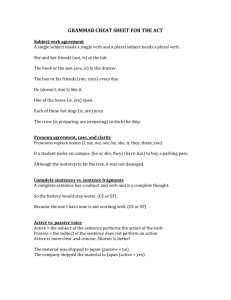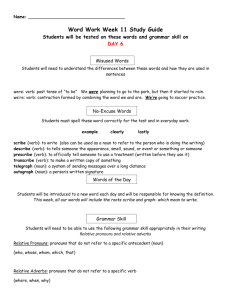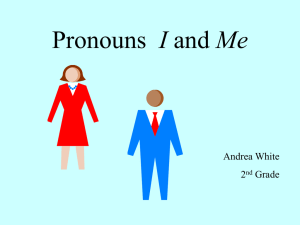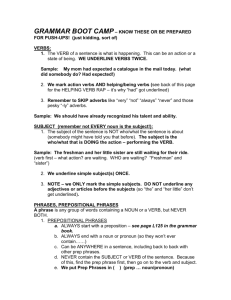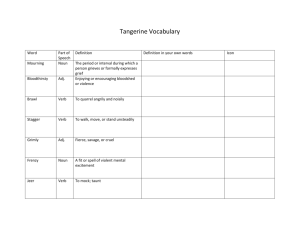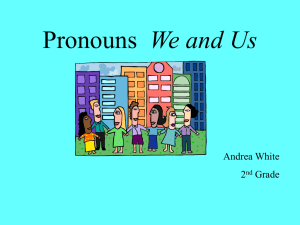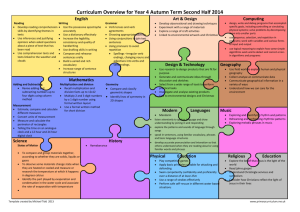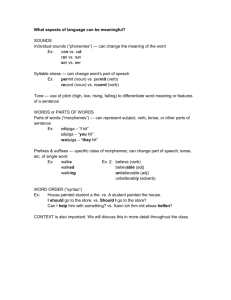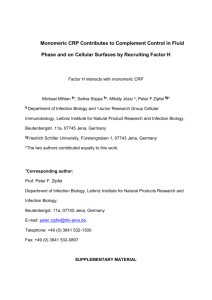Direct Objects
advertisement
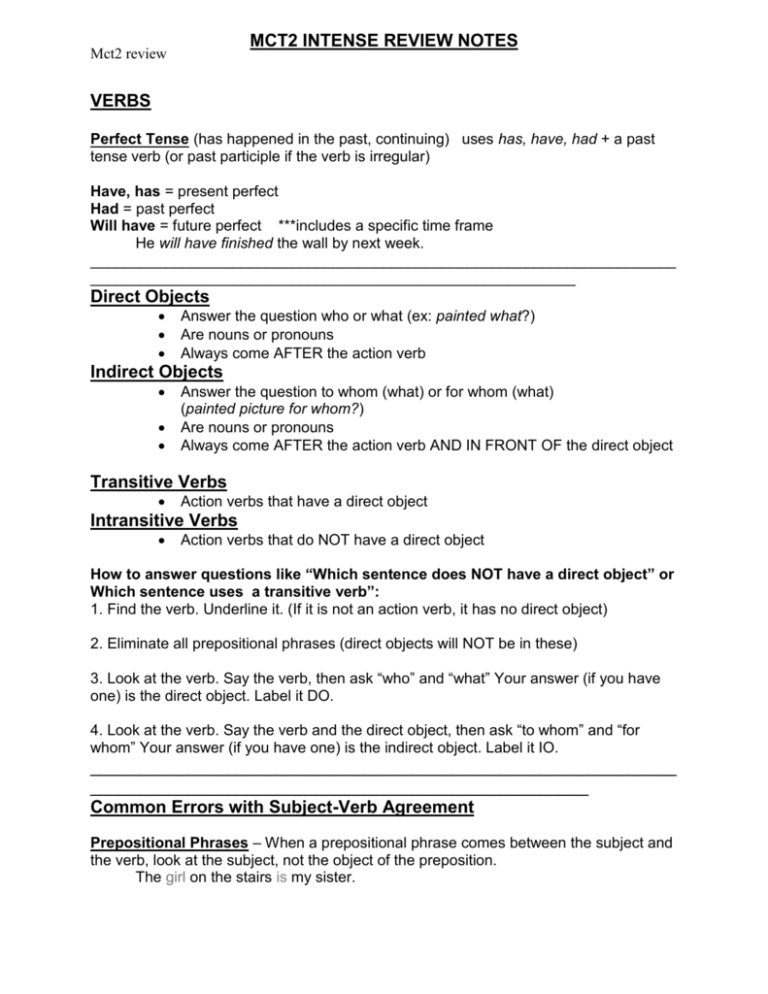
MCT2 INTENSE REVIEW NOTES Mct2 review VERBS Perfect Tense (has happened in the past, continuing) uses has, have, had + a past tense verb (or past participle if the verb is irregular) Have, has = present perfect Had = past perfect Will have = future perfect ***includes a specific time frame He will have finished the wall by next week. ______________________________________________________________________ __________________________________________________________ Direct Objects Answer the question who or what (ex: painted what?) Are nouns or pronouns Always come AFTER the action verb Indirect Objects Answer the question to whom (what) or for whom (what) (painted picture for whom?) Are nouns or pronouns Always come AFTER the action verb AND IN FRONT OF the direct object Transitive Verbs Action verbs that have a direct object Intransitive Verbs Action verbs that do NOT have a direct object How to answer questions like “Which sentence does NOT have a direct object” or Which sentence uses a transitive verb”: 1. Find the verb. Underline it. (If it is not an action verb, it has no direct object) 2. Eliminate all prepositional phrases (direct objects will NOT be in these) 3. Look at the verb. Say the verb, then ask “who” and “what” Your answer (if you have one) is the direct object. Label it DO. 4. Look at the verb. Say the verb and the direct object, then ask “to whom” and “for whom” Your answer (if you have one) is the indirect object. Label it IO. ____________________________________________________________ ___________________________________________________ Common Errors with Subject-Verb Agreement Prepositional Phrases – When a prepositional phrase comes between the subject and the verb, look at the subject, not the object of the preposition. The girl on the stairs is my sister. Mct2 review Sentences that begin with here or there – When a sentence starts with here or there, know that here or there is not the subject. The subject is the item that is here or there. Here is the answer. There are my keys. Compound Subjects: Joined by AND – always plural James and John are brothers. Joined by OR or NOR – look at the last subject, or the one closest to the verb. Either Matt or Kim is coming. Neither the teacher nor the students know the answer. Indefinite Pronouns – these pronouns refer to a group of people or things that are not specifically names. They can be either singular or plural. Be careful to choose the correct verb even though it may sound plural. Singular Anybody, everybody, somebody, nobody, Anyone, everyone, someone, none, one, each, Anything, everything, something, nothing Plural Both, others, Few, several, Many, some Everyone in these two classes has on a T-shirt. Few understand the material. NOUNS AND PRONOUNS Relative pronouns** relate to a noun before them in the same sentence. They come at the beginning of dependent clauses (in complex sentences). They are: Who, Whom, Whoever, Whomever, That, Which When referring to people, use WHO, WHOM, WHOEVER, and WHOMEVER Use WHO or WHOEVER when referring to a noun that is the subject of the clause or sentence. Use WHOM or WHOMEVER when referring to a noun that is the object of the sentence. The girl who won the contest is my sister. (who refers to the girl and is the subject of the clause as well) Do you know the girl whom I said was the winner? (whom refers to the girl and I is the subject of the clause) Mct2 review When referring to things, use WHICH and THAT (that can refer to people, too) Use THAT to begin clauses that HAVE to be in the sentence. Use WHICH* to begin clauses that you COULD leave out. We ate pizza that was three days old. The assignment, which I gave you yesterday, is due today. (*Clauses that begin with which always need commas.) **Relative pronouns can begin relative clauses, usually adjective clauses. ________________________________________________________________ _______________________________________________________ Appositives - a noun or a pronoun that renames another noun or pronoun. Appositives are placed directly after the noun or pronoun they identify. Spot, my black cat, should understand my moods. The appositive “a cat” renames the noun, “Spot.” Appositive phrases – appositives plus modifiers (like adjectives and prepositional phrases) Appositive phrases provide additional information and description to the sentence. As with solitary appositives, appositive phrases are placed near the noun or pronoun they describe. Columbia University, the second-largest landowner in New York City, is part of the Ivy League. David Prowse, the guy in the Darth Vader suit in the Star Wars movies, did not find out that his lines were going to be dubbed over by James Earl Jones until he saw the screening of the movie. Appositives and appositive phrases are usually set apart by commas from the rest of the sentence. Essential (restrictive) appositive phrases – These are NEEDED in the sentence in order to fully understand it. They are NOT separated by commas. o The famous British mystery writer Agatha Christie disappeared in 1924 and was missing for 10 days. Nonessential (nonrestrictive) appositive phrases – These are NOT needed in the sentence; they just add information. They ARE separated by commas. o Agatha Christie, the famous British mystery writer, disappeared in 1924 and was missing for 10 days. Mct2 review Titles of Works Italicize or underline titles of books, magazines, plays, movies, T.V. shows, or newspapers. Harry Potter and the Order of the Phoenix Teen Beat West Side Story Kung Fu Panda I-Carly Laurel-Leader Call Put “quotation marks” around titles of short stories, essays, articles, songs, poems, and chapters in books. “The Gift of the Magi” “My Trip to the Zoo” “Coffee: To Drink or Not to Drink” “Jingle Bells” “The Purple Cow” “The Big Winner” CAPITILIZE the first words, last words, and all important words in titles of works. Do NOT capitalize prepositions, conjunctions, or articles (a, an, the) unless they are the first or last words. The Lord of the Rings “Today’s Schools: What Should A Wonder Book We Do about Absences?” “My Sister Is a Sissy” “A Fly and a Flea in a Flue” Harry Potter and the Chamber of Secrets ______________________________________________________________________ ____________________________________________________________ TYPES OF SENTENCES: Simple – one complete sentence Compound – two or more complete sentences joined by a coordinating conjunction (and, but, or, for, so, yet, nor) with a comma before the conjunction. Complex – one complete sentence plus a subordinate clause (clause that begins with subordinating conjunction) Subordinating conjunctions: After Although As/As if/As though Because Before If Since Though Unless Until When/Whenever Where/Wherever While Even if Even though So that Once As soon as Whether Complex sentences ONLY need a comma when the subordinating conjunction is at the beginning of the sentence! 1. Simple: Polly has a dog named Roxy. 2. Compound: Roxy loves to sleep, but she also loves to play. 3. Complex: When I’m at Polly’s house, I play with Roxy. ______________________________________________________________________ ____________________________________________________________ Mct2 review Sentences with Compound Subjects and Predicates: A compound subject is two or more subjects joined by AND or OR. A compound predicate is two or more predicates joined by AND or OR. Sally and Mark went to the movies. Either Sally or Mark bought the tickets. Mark bought popcorn and shared with Sally. Sally didn’t laugh or cry during the movie. ______________________________________________________________________ ____________________________________________________________ WRITING QUESTIONS: 1. Always read the selections first. Then read the questions carefully. 2. Notice (circle) the TYPE of writing it is. 3. Figure out what the topic is if they don’t tell you. Questions dealing with Topic Sentence, Supporting Details, Conclusions and Introductions: 1. Underline your topic sentence or write the topic out to the side. 2. Read all of the answer choices carefully and look for key words that go with the topic. 3. To figure out an introduction or conclusion, re-read the selection with each possible choice to see which one flows better and fits in with the organization. VIVID WORD CHOICE – You are looking for ACTION words. Something you can clearly picture happening. SENSORY DETAILS – You are looking for ACTION dealing with the 5 senses: sight, smell, taste, touch, and sound. SPECIFIC DETAILS – You are looking for something very specific, seemingly too detailed. DESCRIPTIVE DETAILS – You are looking for lots of ADJECTIVES, very poetic, descriptive language. PURPOSE – Narrative and descriptive=entertain Informative (researched)=inform Taking a stand=persuasive PARAPHRASING – the best summary, including all important information in the shortest way possible. SOURCES – Where you get information from to write a research paper. It should have to do with the topic.
